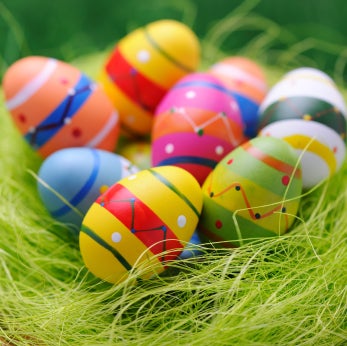Origin Of Easter Eggs
Like most history, the tale of the Easter egg’s existence isn’t exactly a cut and dry explanation. Rather, it’s a story crowded by dozens of conflicting influences, random offshoots, and poetic lore. But though it’s not known exactly how the eggs became united with a bunny, it’s no secret that the art of egg decorating is ancient.

The oldest ever decorated eggshells were discovered in South Africa’s Diepkloof Rock Shelter, dating back to the Paleolithic Period. These 60,000-year-old eggs were expertly engraved with elaborate hatched patterns and thought to have once been colored. Since eggs aren’t exactly iron, it’s pretty impressive that such examples were able to remain somewhat intact after centuries of erosion, ice ages, and natural disasters. But that’s because these ancient fragments aren’t your typical chicken coop ovum – they were ostrich eggs, which are thick. Researchers believe that early humans used them as water flasks due to their durability and capacity to carry about 1 liter of water. As such, they were prized possessions (how else were they going to cart water across barren desserts and eventually make it out of Africa?) and were thus engraved to tell ownership. As mankind progressed, you’d think we might lose sight of the small egg, but we did no such thing.
Thousands of years after hunter-gatherers dominated the world, eggs were more important than ever. Indeed, some of the most advanced civilizations believed that the earth itself started with a simple egg including the Egyptians, Persians, Phoenicians, and Hindus. Birds were worshiped. In the Egyptian religion alone many of the gods and goddesses, even those most important, were avian humanoids including Ra, Horus, and Thoth. On Sham El-Nasim eve, an Egyptian holiday marking the beginning of spring, the ancients would hard boil eggs, decorate them with various patterns, write wishes on them, and hang them from trees or rooftops. Sounds familiar, huh?
Fast forward a few thousand years and head north, eggs become no less prevalent in religions. If you know anything about the art of egg decoration, you’ll have heard of pysanky, or an ancient Ukrainian tradition of using batik to compose intricate designs on the shell. While today they’re linked with all things Easter, the original pysanky began without a Christian in sight. These Slavic design oriented people worshiped Dazboh, a sun god, whose favorite animals were birds, as they could get the nearest to him. Since most eggs are laid in the spring, their presence represented the rebirth of life. Thus, eggs were thought to have magical powers.
As with many traditions, it’s thought that with the advent of Christianity in 988 CE, the egg’s symbolism of the rebirth of life turned into the rebirth of man and pysanka were adapted to represent Christ’s resurrection instead of a link to beloved Dazboh. But other plausible links between old religions and the new also exist.
Another possible starting point for the Easter egg is just a few hundred years later in some pagan worshiping Germanic tribes. In Norse mythology, Ostara (known as Oestra or even Eastre) was the Germanic goddess of springtime, fertility, and rebirth. (Could her name be any closer to the modern holiday?) According to Anglo-Saxon myth, Ostara, being a fertility goddess and all, was a good friend of children. She also had a prized pet bird. To amuse the little Germanic youngsters, Ostara turned her winged creature into a slightly different fertility symbol: a rabbit. After its transformation, the rodent’s looks changed, but it retained some of its original qualities, like laying eggs. Oddly enough, they were brightly colored and given to the children.
While the latter tale seems to be spot on with modern day traditions, it’s likely a story too good to be true. It’s been suggested that this myth was possibly invented by Venerable Bede, the English monk known as The Father of English History. In 750 CE, Bede wrote a book in which he mentioned Ostara’s connection with the pagan festival Eosturmonath…but before this name drop there’s basically nothing written about her. Strange, no?
But though the history of the Easter egg may be pretty murky, it’s easy to conclude that the art of decorating is ancient. So this year, when you break out the food coloring and swirly metal egg holder things, remember to give eggs a little more credit than just being delicious when hardboiled.